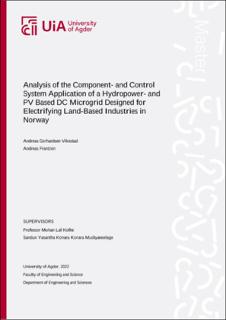| dc.description.abstract | The Norwegian Water Resources and Energy Directorate reports that a significant share of Norway’s
greenhouse gas emissions originates from burning fossil fuelsin the land-based industry. Although some
electrification and energy cuts have been initiated, the current technology for further electrification,
particularly chemical industries, is classified as “immature”. The electrification development of such
industries is recognized as a critical step in reducing Norway’s land-based industry’s carbon footprint.
However, this requires considerable investments in the public grid. Intending to address this, the thesis
attains the NWA concept by proposing a hydropower- and PV based DC microgrid structure using
hybrid energy storage.
The software MATLAB Simulink is used to design, model, and simulate the microgrid. The model
covers a 100 kW PV system, an 85 kVA rated salient pole synchronous generator and an energy storage
system incorporating either exclusively a battery system or in conjunction with a supercapacitor system.
This system undertakes three modes of operation, simulated for two different load cases with different
demand responses. The goal is to determine a control system- and component applications that satisfy a
predetermined stability requirement while sharing out the power contributions to saturate the load
demand. For the first two modes of operation, the DC bus is controlled by the HES system, whereas the
generator operates first with constant rotation and field voltage, and then with an excitation system. In
the third mode of operation, the DC bus is controlled by the generator system, while the battery system
is tasked with saturating the remaining load demand.
The thesis concludes that the proposed system shows promising characteristics for electrifying land-based industry, and the obtained robustness in the control system is satisfactory for selected component
applications. Moreover, the system can somewhat attain the NWA concept, although the obstacle of
safeguarding energy storage capacity must be overcome to practically implement it. | |
